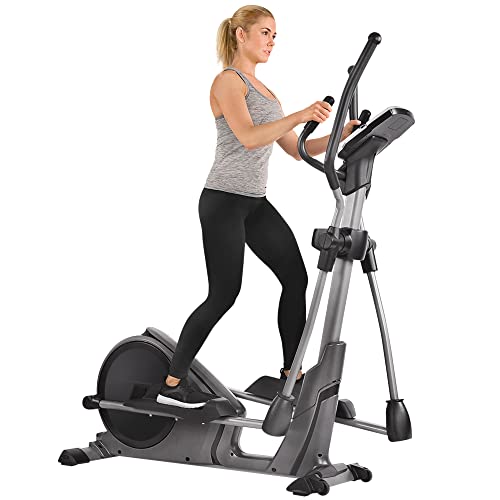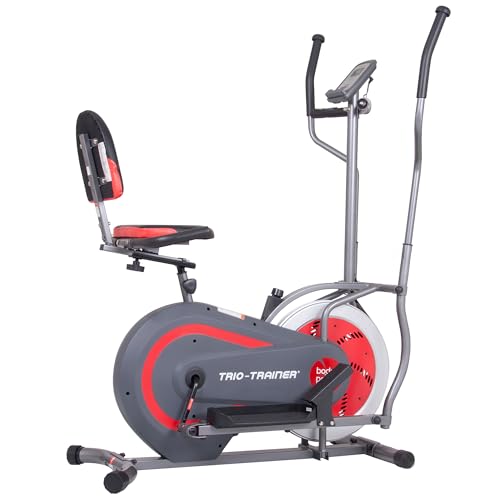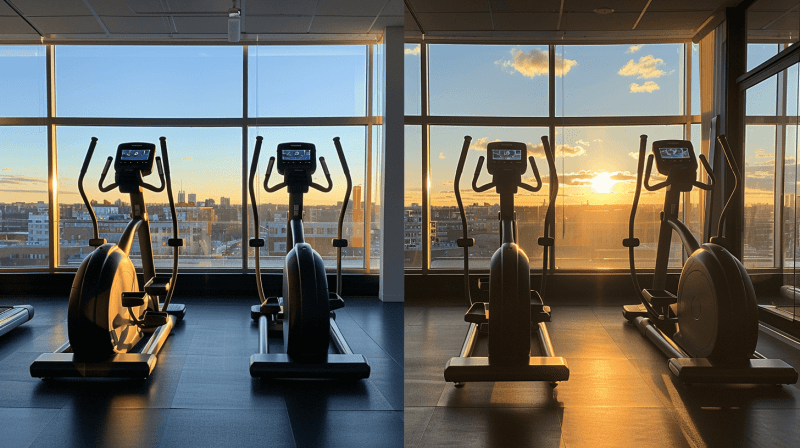While the elliptical machine might look deceptively simple, it's actually one of the most effective tools for total-body transformation. You'll likely notice your first results within 3-4 weeks of consistent training, as your endurance improves and daily activities become easier to manage. Yet the most visible changes to your body composition typically won't appear until the 6-8 week mark, depending on your commitment and workout intensity. If you're wondering whether you're approaching your elliptical routine in the most efficient way possible, there's more to the story than simply stepping on and starting to stride.
Key Takeaways
-
Initial cardiovascular improvements and increased endurance become noticeable within 3-4 weeks of consistent elliptical training.
-
Visible weight loss and body composition changes typically emerge after 6-8 weeks of regular workouts.
-
Most people burn 170-320 calories per 30-minute session, with results varying based on intensity and body weight.
-
Combining elliptical training with proper diet and 5+ weekly sessions accelerates visible results and fitness improvements.
-
Individual results depend on factors like age, starting fitness level, metabolism, and workout intensity.
Understanding Elliptical Training Benefits
Through consistent elliptical training, you'll tap into a wealth of fitness benefits that impact your entire body. The elliptical machine stands out as a versatile exercise machine that delivers extensive results while being gentle on your joints. When you engage in this type of workout, you're simultaneously working multiple muscle groups while building cardiovascular endurance. Regular workouts can lower bad cholesterol within three to six months of consistent training.
The calorie-burning potential of elliptical exercise is particularly impressive. You can expect to burn between 170-320 calories during a focused 30-minute session, making it an efficient choice for weight management goals. The full-body nature of the workout means you're maximizing your time and energy expenditure with every stride.
Your fitness journey on the elliptical becomes even more effective when you incorporate interval training and resistance variations. By adjusting these elements, you'll challenge your body in different ways, leading to improved muscle tone and enhanced cardiovascular capacity. The machine's adaptability allows you to progressively increase intensity as your strength and endurance grow, ensuring continued progress regardless of your starting fitness level. For optimal results, combine your elliptical workouts with strength training exercises to improve lean muscle mass while decreasing body fat.
Realistic Timeline for Physical Changes
While understanding the benefits of elliptical training sets expectations, you'll want to know exactly when these positive changes start appearing in your body. With consistent elliptical workouts, you'll begin noticing improvements in muscle strength and cardiovascular health within 3-4 weeks of regular training.
The timeline for weight loss and visible body changes typically extends to 6-8 weeks, provided you're maintaining a caloric deficit through your aerobic exercise routine. Your elliptical trainer sessions, especially when incorporating high-intensity interval training (HIIT), can help maximize the amount of calories burned during each workout. Pre-designed workout regimens can help you maintain variety and stay motivated throughout your fitness journey.
Your individual results will vary based on several key factors. Age, starting fitness level, and current body composition play significant roles in determining how quickly you'll see changes. Additionally, your diet, exercise intensity, and consistency with your workouts will impact the weeks to see results. To optimize your progress, focus on:
- Maintaining proper form during workouts
- Gradually increasing resistance levels
- Incorporating interval training
- Supporting your exercise with proper nutrition
- Getting adequate rest between sessions
The forward-backward motion on an elliptical is generally more effective than up-down movement patterns for achieving optimal results.
Factors Affecting Your Results
The success rate of your elliptical workouts depends on a complex interplay of personal and lifestyle factors. Your body weight directly influences the number of calories burned during each session, while your exercise intensity determines the effectiveness of your cardiovascular improvements. These elements work together to create your unique fitness trajectory. Adjustable resistance levels can help you customize your workouts for optimal results as you progress.
Your diet plays an essential role in how quickly you'll see results from elliptical training. Even if you're spending consistent minutes on the machine, poor nutritional choices can considerably slow your progress toward your fitness goals. Additionally, factors like your age, metabolism, and initial fitness level will impact how your body responds to the exercise.
Low-impact exercise makes the elliptical an excellent choice for maintaining consistency in your workout routine without risking joint strain or injury. The key to maximizing results lies in maintaining a balanced approach. You'll need to focus on:
- Keeping your exercise intensity at an appropriate level for your fitness stage
- Following a nutritious diet that supports your workout efforts
- Getting adequate rest between sessions
- Gradually increasing your workout duration and resistance
Remember that tracking these variables can help you adjust your routine for ideal results, ensuring you're making steady progress toward your desired outcomes.
Essential Workout Techniques
Don't forget to include backward motion in your elliptical sessions. This technique targets often-neglected muscle groups, particularly your hamstrings and posterior chain muscles. Maintaining proper arm movement with elbows at 90 degrees helps optimize the full-body benefits of both forward and backward pedaling.
Optimizing Your Training Schedule
Establishing an effective training schedule maximizes your results on the elliptical. For prime outcomes, you'll want to commit to using the elliptical at least five times per week, with each session lasting between 30-60 minutes. This consistent schedule, combined with a proper diet, creates the foundation for sustainable weight loss and fitness improvements.
Structure your weekly routine by incorporating varied workout intensities. Plan for 2-3 high-intensity interval training sessions per week while using elliptical machines, as these sessions are particularly effective at burning more calories.
For your remaining workouts, focus on steady-state cardio at a moderate intensity, gradually increasing the resistance and duration as your fitness improves.
Don't forget to schedule 1-2 rest days between your training sessions. These recovery periods are essential for preventing burnout and allowing your muscles to adapt to the increased activity. Track your minutes on the elliptical, resistance levels, and distance covered during each session. This data helps you monitor progress and adjust your training schedule as needed, ensuring you're consistently challenging yourself while avoiding overtraining.
Tracking Progress and Measurements
Monitoring your progress on the elliptical helps maintain motivation and guarantees you're moving toward your fitness goals. By tracking the calories you burn, duration and intensity, and cardiovascular metrics, you'll have concrete data to evaluate your improvements. This form of exercise typically shows measurable results when you consistently track key performance indicators.
Start by recording baseline measurements, including your body fat percentage, weight, and initial fitness level. You'll want to document your workouts, noting how long you exercise and how hard you work harder over time. Most users notice significant health benefits within 3-4 weeks, particularly in muscle definition and cardio endurance.
Create a progress tracking system that includes:
- Weekly measurements of weight and body composition
- Daily workout statistics (distance, time, resistance level)
- Monthly progress photos
- Regular fitness assessments
- Heart rate data during exercise
Common Mistakes to Avoid
Successfully achieving results on the elliptical requires avoiding several common pitfalls that can hinder your progress. To lose a significant amount of weight and burn calories effectively, you'll need to maintain proper form and technique during your workout on the elliptical.
One critical mistake is poor posture, specifically hunching over the handles, which can strain your back and reduce the effectiveness of your high-intensity workout. Additionally, many users rely too heavily on the arm handles instead of engaging their leg muscles, which diminishes the caloric burn and muscle-building potential.
Another common error is maintaining the same resistance level indefinitely. To see continued results, you need to progressively increase high resistance levels and maintain an elevated heart rate. The elliptical, when used correctly, should challenge your cardiovascular system and muscles consistently.
Proper nutrition and hydration are equally important factors that users often overlook. Without adequate fuel and hydration before and after your sessions, your body won't perform at its best or recover effectively.
Finally, inconsistent training schedules can severely impact your results - maintaining a regular workout routine is indispensable for achieving your fitness goals.
Nutrition and Recovery Tips
The right nutrition and recovery practices work hand-in-hand with your elliptical workouts to maximize results. Maintaining a balanced diet with a moderate calorie deficit helps optimize weight loss while supporting muscle recovery. You'll want to prioritize your protein intake, aiming for 1.6-2.2 grams per kilogram of body weight to support muscle building and repair processes.
Proper hydration plays a pivotal role in your fitness journey. Make sure you're drinking 0.5-1 gallon of water daily to maintain essential exercise performance and support your body's natural recovery mechanisms. This becomes especially important when you're regularly using the elliptical.
Quality sleep and stress management are often overlooked but indispensable components of your fitness routine. Getting 7-9 hours of sleep each night helps regulate hormones that influence weight loss and supports muscle recovery. Additionally, incorporating stress management techniques like meditation or yoga can help maintain hormonal balance, which directly impacts your body's ability to lose weight and build muscle.
Remember to view nutrition and recovery as equally important as your elliptical workouts - they're all interconnected pieces of your fitness success puzzle.
Building an Effective Exercise Plan
Creating a structured exercise plan is essential for maximizing your elliptical workout results. Using an elliptical consistently can help you burn a significant amount of weight when you follow a well-designed program that combines both steady-state cardio and high-intensity intervals.
Start with 30-minute sessions at moderate intensity, focusing on proper form and engaging your upper body through the machine's handles. This burns more calories than lower body movement alone.
Progress to 45-60 minute workouts as your stamina improves, incorporating intervals where you alternate between high and low intensities every 2-3 minutes.
Track the number of calories burned during each workout on an elliptical, adjusting resistance and incline to create a caloric deficit of 500-750 calories per session.
Your weekly fitness equipment schedule should include at least five elliptical sessions, with rest days strategically placed to prevent burnout. Remember to gradually increase workout intensity and duration as your fitness improves. Monitor your progress using the machine's built-in metrics or a fitness tracker, ensuring you're consistently challenging yourself while maintaining proper form.
Advanced Training Strategies
Advanced training techniques on the elliptical can dramatically accelerate your fitness results once you've mastered the basics. By incorporating HIIT workouts into your routine, you'll burn even more calories and boost your athletic performance beyond what moderate intensity sessions can achieve.
To maximize your total body workout, alternate between high-intensity bursts (30-60 seconds) and active recovery periods (1-2 minutes) while engaging the arm handles. This approach not only improves cardiovascular endurance but also triggers a significant afterburn effect that continues burning calories hours after your workout.
Progressive overload is essential for continued improvement. Start by gradually increasing resistance levels and incline settings every 2-3 weeks. You'll notice enhanced muscle definition and strength, particularly when you incorporate reverse pedaling into your routine. This variation targets different muscle groups and prevents training plateaus.
Track your metrics religiously using the machine's built-in monitors or fitness apps. By recording your distance, speed, and calorie burn, you'll be able to objectively measure progress and adjust your training intensity accordingly. This data-driven approach guarantees you're consistently challenging yourself across all forms of cardio on the elliptical.
Frequently Asked Questions
Can You Get in Shape Just Using an Elliptical?
You'll get partial results from elliptical workouts alone, but for complete fitness, you'll need cross-training. While you'll gain cardiovascular benefits and some muscle toning, combine it with strength training for ideal results.
How Fast Can You Lose Weight on an Elliptical?
Like a fat-melting machine, you'll burn 300-500 calories per 30-minute session. With consistent elliptical routines and proper intensity adjustments, you can realistically lose 1-2 pounds weekly while following a calorie-deficit diet.
What Will 30 Minutes a Day on the Elliptical Do?
You'll strengthen multiple muscle groups, boost cardiovascular endurance, and burn 170-320 calories with daily 30-minute elliptical workouts. It's a low-impact exercise that's gentle on joints while improving overall fitness.
Are Ellipticals Good for Losing Belly Fat?
Like a sculptor chiseling away, you'll melt belly fat through consistent elliptical workouts. Adjust incline settings and resistance levels while maintaining high intensity. Your weight impacts calorie-burning rates, but cross-training benefits accelerate results.
Conclusion
Like a marathon runner's steady journey to the finish line, your elliptical success story won't happen overnight. You'll notice initial cardiovascular improvements within 3-4 weeks, with more visible results emerging around the 6-8 week mark. By maintaining consistent training, proper form, and a balanced nutrition plan, you're setting yourself up for sustainable fitness gains. Remember, it's not just about the destination - each stride on your elliptical brings you closer to your goals.







